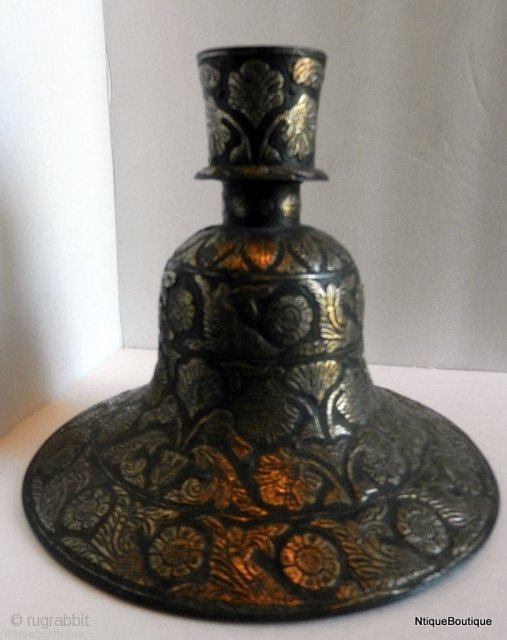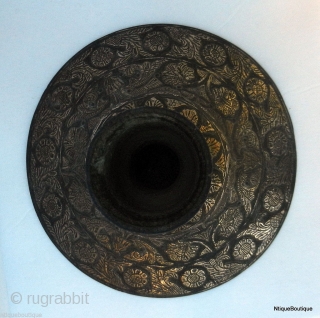Back
Rare Mughal Bidri Hukka base
India,Lucknow,Huqqa,Silver,Nawab,Raja,Tobacco,Pipe
Nicely preserved,authentic & rare Mughal Bidri Hukka in excellent condition with more than 95% silver-work intact, Dimension: 5 1/4 x 6 3/4.Original & never repaired
The origin of Bidriware is usually attributed to the Bahamani sultans who ruled Bidar in the 13th–15th centuries. Abdullah bin Kaiser, a craftsman from Iran was invited by the Sultan to work on decorating the royal palaces and courts. According to some accounts, Kaiser joined hands with local craftsmen and gave birth to Bidriware. Since then, the craft has been handed down succeeding generations mostly among the local Muslim and Lingayat sects.
Bidriware is manufactured from an alloy of copper & zinc (in the ratio 1:16) by casting. The zinc content gives the alloy a deep black color. First, a mould is formed from soil made malleable by the addition of castor oil and resin. The molten metal is then poured into it to obtain a cast piece which is later smoothed by filing. The casting is now coated with a strong solution of copper sulphate to obtain a temporary black coating over which designs are etched freehand with the help of a metal stylus. This is then secured in a vise and the craftsman uses small chisels to engrave the design over the freehand etching. Fine wire or flattened strips of pure silver are then carefully hammered into these grooves.
The article then is filed , buffed and smoothed to get rid of the temporary black coating. This results in rendering the silver inlay hardly distinguishable from the gleaming metallic surface which is now all silvery white. The bidri ware is now ready for the final blackening process. Here, a special variety of soil which is available only in the unlit portions of the Bidar fort is used. It is mixed with ammonium chloride and water to produce a paste which is then rubbed onto a heated bidri surface. The paste selectively darkens the body while it has no effect on the silver inlay. The paste is then rinsed off to reveal a shiny silver design resplendent against the black surface. As a finishing touch, oil is applied to the finished product to deepen the Matt coating. The finished product appears black with brilliant silver inlay.
supreme
price:
685.00
- Home
- Antique Rugs by Region
- Category
- Profiles
- Post Items Free
- Albums
- Benaki Museum of Islamic Art
- Budapest: Ottoman Carpets
- Gulbenkian Museum
- Islamic Carpets. Brooklyn
- Islamic Textiles. Brooklyn
- Konya Museum: Rugs
- MKG, Hamburg
- MMA: Caucasian Carpets
- MMA: Mamluk Carpets
- MMA: Mughal Indian Carpets
- MMA: Ottoman Carpets
- MMA: Safavid Persian Carpets
- MMA: Turkmen Rugs
- McCoy Jones Kilims
- Ottoman textiles. Met
- Philadelphia Museum
- Rugs and Carpets: Berlin
- Seljuqs at the Met
- TIEM, Istanbul: Carpets
- V&A: Classical Carpets
- Vakiflar Carpets: Istanbul
- Baluch Rugs: Indianapolis
- Gallery Exhibitions
- Jaf an Exhibition
- Alberto Levi Gallery
- Andean Textile
- Christie's London: 2016
- Francesca Galloway
- HALI at 40
- ICOC Washington, DC 2018
- Jajims of the Shahsavan
- London Islamic Week April, 2018
- Mongolian Felts
- Navajo Rugs: JB Moore
- Persian Piled Weavings
- SF Tribal & Textile Art Show 2020
- SF Tribal 2019
- Sotheby's: C. Alexander
- Turkish Prayer Rugs
- Turkmen Main Carpets ICOC 2007








